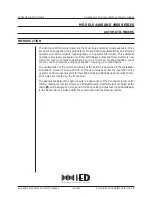
4
The ON switch turns on all post-fade
outputs from the channel when pressed.
Note that the Insert point is unaffected
by the ON switch.
The linear FADER gives you smooth control
of the overall signal level in the channel
strip, allowing precise balancing of the
various source signals being mixed to the
Master Section.
When the latching PFL switch is pressed, the pre-fade signal is fed
to the headphones or monitor outputs, replacing the selected
source (either Mix or Tape Return). The signal is also displayed on
the right PPM meter. This is a useful way of listening to any one or
more signals without interrupting the main mix, for adjusting signal
quality or to set the input GAIN.
This LED indicator warns when an
excessively high signal level is
present in the channel and will
illuminate approximately 4dB before
clipping
The input channel signal is always routed to MIX or GROUPS
as selected by the two ROUTING switches. The upper switch
selects MIX when released or GROUPS when pressed, while
the lower switch chooses between Groups 1-2 when released
or Groups 3-4 when pressed.
These are always POST-FADE and would normally be used to
drive effects processing units which are fed back into the mixer
and which must fade out with the input channel. Aux 4 is an
individual mono send, while the 5/6 STE knob feeds the
channel signal via the PAN control (see below) as a stereo pair
to either Aux outputs 5 & 6 or, with the 7-8 switch pressed, to
Aux outputs 7 & 8.
The Equaliser (EQ) allows precise manipulation of the sound,
particularly to improve the sound in live PA applications where the
original signal is often far from ideal. There are three sections, HF,
MID and LF giving the sort of control usually only found on much
larger mixers. The EQ knobs can have a dramatic effect, so use
them sparingly and listen carefully as you change any settings so
that you get to know how they affect the sound.
These controls route the input channel signal
to any one or more of eight Auxiliary busses,
which combine the sends from each channel,
mixing them to separate outputs on the rear of
the mixer. Since they are independent of the
main outputs they can provide additional
sources for foldback, effects processors or
extra loudspeaker `fills'. Leave the knobs
turned fully anticlockwise when not in use.
This send can be set pre-fade, pre-EQ or
post-fade as required by the AUX 3 PRE
switch on the Master Section.
The EQ switch bypasses the Equalisation section when released and
places it into the channel path when pressed. It would typically be
used for simple comparison of the equalised and unequalised signal.






































